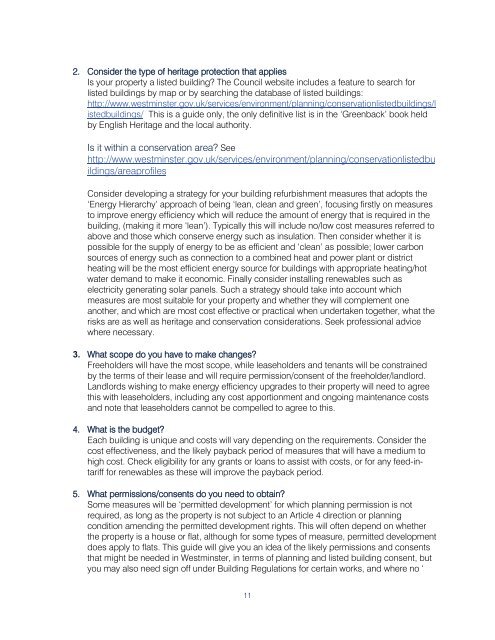Retrofitting Historic Buildings - Westminster City Council
Retrofitting Historic Buildings - Westminster City Council
Retrofitting Historic Buildings - Westminster City Council
You also want an ePaper? Increase the reach of your titles
YUMPU automatically turns print PDFs into web optimized ePapers that Google loves.
2. Consider the type of heritage protection that appliesIs your property a listed building? The <strong>Council</strong> website includes a feature to search forlisted buildings by map or by searching the database of listed buildings:http://www.westminster.gov.uk/services/environment/planning/conservationlistedbuildings/listedbuildings/ This is a guide only, the only definitive list is in the ‘Greenback’ book heldby English Heritage and the local authority.Is it within a conservation area? Seehttp://www.westminster.gov.uk/services/environment/planning/conservationlistedbuildings/areaprofilesConsider developing a strategy for your building refurbishment measures that adopts the‘Energy Hierarchy’ approach of being ‘lean, clean and green’, focusing firstly on measuresto improve energy efficiency which will reduce the amount of energy that is required in thebuilding, (making it more ‘lean’). Typically this will include no/low cost measures referred toabove and those which conserve energy such as insulation. Then consider whether it ispossible for the supply of energy to be as efficient and ‘clean’ as possible; lower carbonsources of energy such as connection to a combined heat and power plant or districtheating will be the most efficient energy source for buildings with appropriate heating/hotwater demand to make it economic. Finally consider installing renewables such aselectricity generating solar panels. Such a strategy should take into account whichmeasures are most suitable for your property and whether they will complement oneanother, and which are most cost effective or practical when undertaken together, what therisks are as well as heritage and conservation considerations. Seek professional advicewhere necessary.3. What scope do you have to make changes?Freeholders will have the most scope, while leaseholders and tenants will be constrainedby the terms of their lease and will require permission/consent of the freeholder/landlord.Landlords wishing to make energy efficiency upgrades to their property will need to agreethis with leaseholders, including any cost apportionment and ongoing maintenance costsand note that leaseholders cannot be compelled to agree to this.4. What is the budget?Each building is unique and costs will vary depending on the requirements. Consider thecost effectiveness, and the likely payback period of measures that will have a medium tohigh cost. Check eligibility for any grants or loans to assist with costs, or for any feed-intarifffor renewables as these will improve the payback period.5. What permissions/consents do you need to obtain?Some measures will be ‘permitted development’ for which planning permission is notrequired, as long as the property is not subject to an Article 4 direction or planningcondition amending the permitted development rights. This will often depend on whetherthe property is a house or flat, although for some types of measure, permitted developmentdoes apply to flats. This guide will give you an idea of the likely permissions and consentsthat might be needed in <strong>Westminster</strong>, in terms of planning and listed building consent, butyou may also need sign off under Building Regulations for certain works, and where no ‘11
















